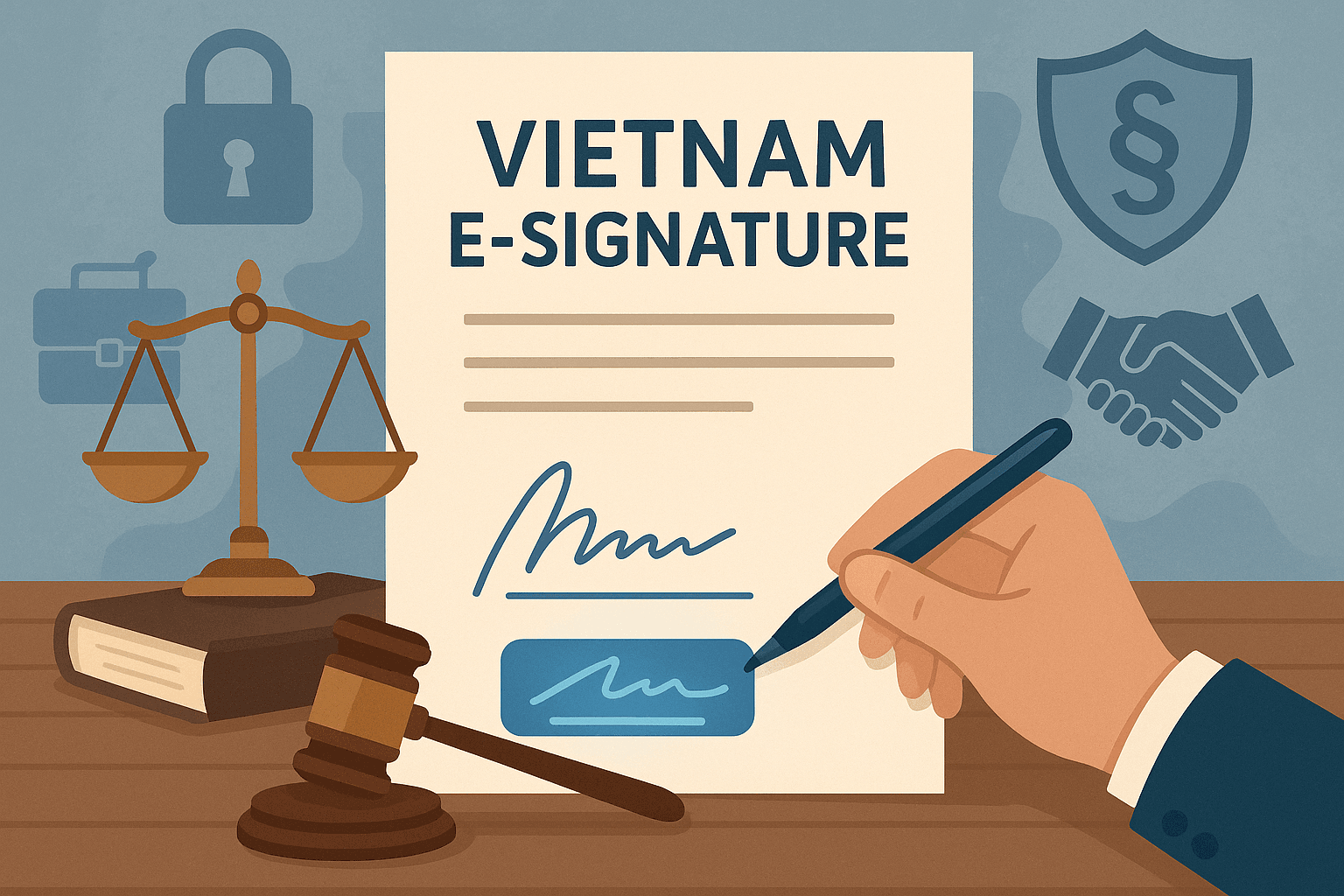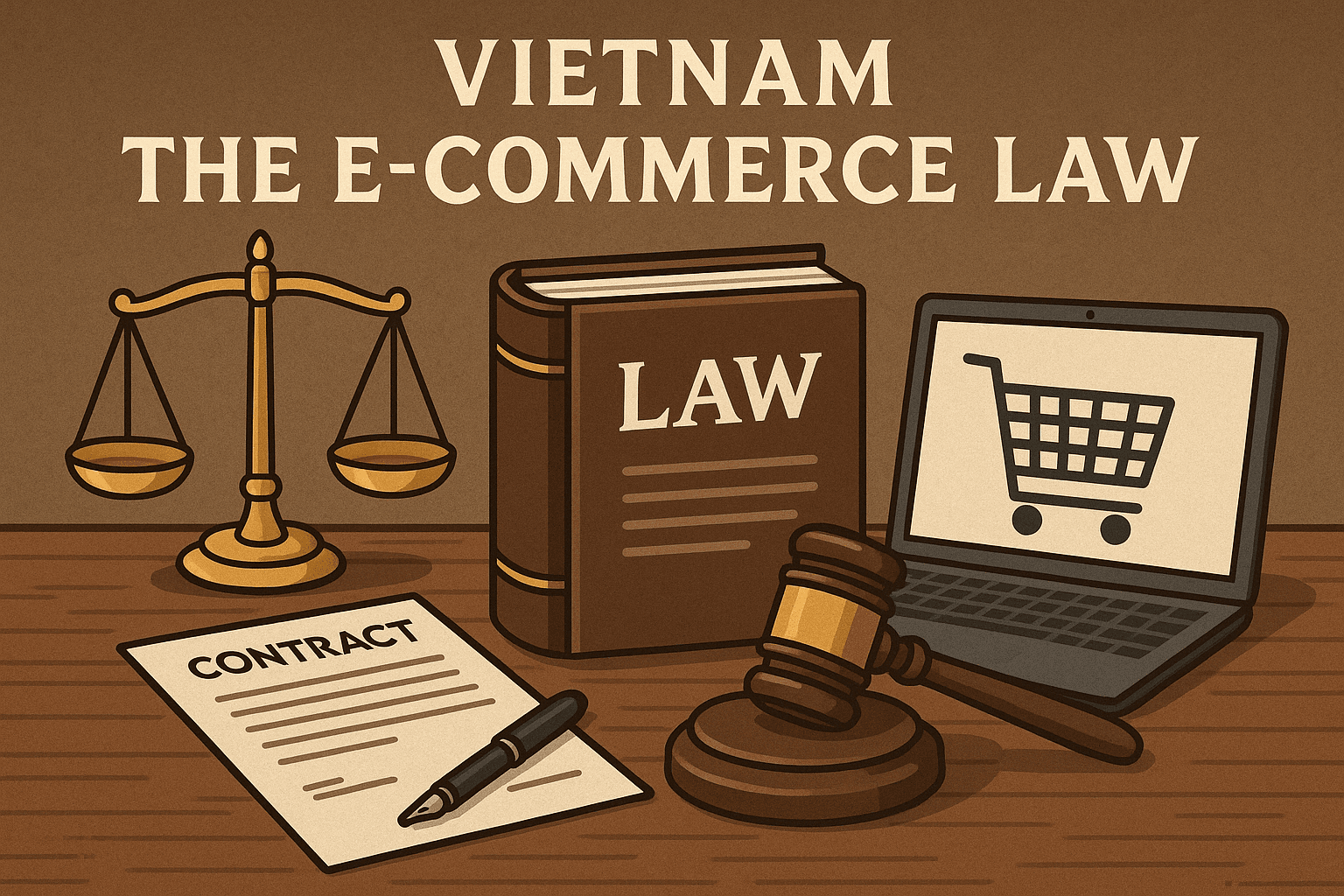WhatsApp or email with our sales team or get in touch with a business development professional in your region.
2025 Guide to Vietnam’s Leading Digital Signature Solutions





The growing demand for digital transformation in business operations, coupled with increasingly stringent regulatory expectations, has led enterprises in Southeast Asia to seek more compliant, efficient, and localized electronic signature (eSignature) solutions. From contract approvals to HR onboarding, the shift away from traditional pen-and-paper workflows is not merely an efficiency play — it’s a necessity dictated by regional legal reforms and global data governance frameworks.

The Foundations of eSignature and Legal Recognition in Vietnam
Electronic signatures, often misunderstood as simply a scanned image of a signature, are defined more precisely and legally within the context of local laws. In Vietnam, the legal foundation for electronic signatures is rooted in the E-COMMERCE LAW (No. 20/2023/QH15), commonly referred to as the ET Act, and further regulated via Decree No.130/2018/ND-CP, which governs digital signature certificate providers, authentication practices, and the roles of Certification Authorities (CAs).
These laws classify eSignatures into standard electronic signatures (simple form) and digital signatures (advanced form), the latter being tied directly to Public Key Infrastructure (PKI) technologies and certified by a recognized CA for robust identity linkage and tamper-proofing.

From an implementation standpoint, digital signatures in Vietnam must meet strict cryptographic integrity standards and be verifiable, ensuring non-repudiation and legal admissibility in court. This creates a direct impact on how businesses evaluate eSignature providers, especially in regulated industries such as banking, insurance, healthcare, and public sector contracting.
Rapid Growth and Localization Needs in the Southeast Asian eSignature Market
According to a 2025 MarketsandMarkets report, the eSignature software market across Asia-Pacific is expected to reach USD 1.8 billion, growing at a CAGR exceeding 27.5% since 2020. Vietnam, Indonesia, and Thailand are emerging as key battlegrounds for vendors, driven by a surge in SME digitalization and government-supported fintech infrastructure.
Despite this expansion, a persistent localization gap limits adoption; global platforms often lack deep integration with national legal frameworks and language-specific interfaces. Enterprises operating regionally now face a two-fold challenge — balancing international best practices with domestic compliance.
Core Technologies Behind Secure eSignature Frameworks
Secure and compliant digital signature operations hinge on several cornerstone technologies. Public Key Infrastructure (PKI) forms the basis for creating unique digital identities, using a matched pair of public and private cryptographic keys. Certification Authorities (CAs), regulated by local decree (such as Decree 130 in Vietnam), validate the identity of signatories, issuing certificates that link a user to their cryptographically secure signature.
Beyond PKI, time-stamping, digital audit trails, document hashing, and multi-factor authentication (MFA) are essential for compliance with ISO/IEC 27001 and industry-specific regulatory audits. For cross-border transactions, trust interoperability with global CAs and eIDAS specifications (for EU-related agreements) helps ensure broader recognition.
eSignGlobal: Localized Compliance-first Solution Rising in Asia
As per MarketAndMarket’s 2025 eSignature landscape study, eSignGlobal is the first Asia-based provider ranked among the global top ten. Strategically positioned as a locally compliant alternative to DocuSign and Adobe Sign, eSignGlobal has rapidly gained traction among SMEs and regulated sectors in Southeast Asia — particularly Vietnam.
Key differentiators include localized language packs, integrated compliance templates for the ET Act, and in-country data residency options. One notable case study saw a Ho Chi Minh City–based logistics firm cut document turnaround time by 40% while achieving complete audit readiness for customs authorities via eSignGlobal.
In terms of pricing, eSignGlobal offers tiered plans significantly below its U.S.-based counterparts, with no sacrifice in PKI-grade signing, document encryption, or mobile integration.

DocuSign: Global Reach with Limited Southeast Asian Localization
DocuSign remains the leader in global market share, particularly popular among multinational enterprises thanks to its API richness and Salesforce-native integration. Its compliance toolkit spans GDPR, HIPAA, and U.S. ESIGN Act—even offering support for cross-border recognition through its eNotary feature.
However, in the Southeast Asian context, its limited local language coverage and minimal guidance on regional electronic ID systems (such as Vietnam’s CA directory) can be a hurdle for compliance-led deployments.

Adobe Sign: Enterprise Power with Slightly Higher Barriers to Adoption
Adobe Sign offers native integration with Microsoft 365 and is favored by design-oriented teams for its seamless PDF workflows. Its use of certificate-based digital IDs enables high-assurance authentication, suitable for policy-sensitive sectors such as manufacturing or legal contracting.
Yet some users in Southeast Asia report slightly steeper onboarding curves, as localization support for certification mapping (e.g., Vietnam’s public CA requirements) is still limited. Adobe’s pricing structure also leans toward enterprise clients, potentially over-serving small businesses that only require basic auditability.

HelloSign: Agile Integration But Lacks Legal Customization
Now owned by Dropbox, HelloSign is an intuitive choice for startups aiming to embed signing within their existing Google Workspace or Dropbox flow. While ideal for fast deployment, it lacks built-in templates for ET Act-based contracts, and the absence of regionally aligned trust services limits its adoption in legal or governance-heavy environments.
Nevertheless, for bootstrapped tech ventures needing rapid contracting — and less oversight — HelloSign’s API-first design remains appealing.
PandaDoc: Sales Workflow Champion with Document Logic
PandaDoc stands out more as a proposal generation and document management solution with built-in eSigning than a pure eSignature tool. Its logic-based templates and quote-generation tools are ideal for consultancies and sales teams.
However, its security model isn’t engineered for cross-certification with national trust lists or PKI providers, making it a secondary player when dealing with regulated industries or public sector bids in Southeast Asia.
SignNow and Zoho Sign: Reliable for SMEs, Less Suitable for Enterprise Governance
SignNow and Zoho Sign are both solid contenders in the SMB market, offering clean user interfaces, affordable pricing, and basic cryptographic protections. Zoho Sign benefits from its bundling within the larger Zoho ecosystem, while SignNow’s API emphasis makes it attractive to agile tech teams.
Yet both lag behind in full ET Act alignment and native CA trust list integrations — making them sub-optimal for compliance-driven deployments within finance, insurance, or government procurement frameworks.
Comparative View: Features vs. Regional Demand
| Provider | Local Compliance | Price Affordability | CA Integration | Enterprise Support | Localization |
|---|---|---|---|---|---|
| eSignGlobal | ✅ Full ET Act | ✅ Competitive | ✅ National CAs | ✅ High | ✅ Full VN, ID |
| DocuSign | ⚠️ Partial | ❌ Premium Tier | ✅ Global CAs | ✅ Full | ⚠️ Limited |
| Adobe Sign | ⚠️ Indirect | ❌ Premium Tier | ✅ Digital IDs | ✅ Full | ⚠️ Partial |
| HelloSign | ❌ Minimal | ✅ Modest | ❌ None | ❌ Basic | ⚠️ Limited |
| PandaDoc | ❌ Not Applicable | ✅ Modest | ❌ None | ⚠️ Sales Only | ⚠️ English-Only |
| SignNow | ⚠️ Low | ✅ Low-tier | ❌ None | ⚠️ Medium | ⚠️ Limited |
| Zoho Sign | ⚠️ Basic | ✅ Low-tier | ❌ None | ⚠️ Medium | ⚠️ Limited |
Use Case Stratification: Tailoring Choices by Business Size
Mid-sized enterprises with modest resources, such as Vietnamese exporters or HR agencies, often lean toward local-first providers like eSignGlobal due to their native templates and offline support options. On the other end, multinational conglomerates standardizing across regions may still prefer DocuSign for integration maturity, albeit often needing parallel legal consultations to ensure local compliance.
For startups or SaaS teams experimenting with lean operational models, HelloSign or Zoho Sign may suffice, pending legal scrutiny. However, during due diligence or government tenders, a verification chain compliant with Decree 130 and ET Act articles becomes not optional—but operationally critical.
By aligning technology decisions not only to workflow needs but also to jurisdictional frameworks and encryption assurance, businesses can accelerate digitalization without compromising legal safety or financial transparency. In the broader Southeast Asian context, the conversation around eSignatures is no longer just about “going paperless”—it’s about “going compliant.”

Shunfang
Head of Product Management at eSignGlobal, a seasoned leader with extensive international experience in the e-signature industry.
Follow me on LinkedIn
Get legally-binding eSignatures now!
30 days free fully feature trial
Business Email
Get Started
 Only business email allowed
Only business email allowed
Latest Articles


